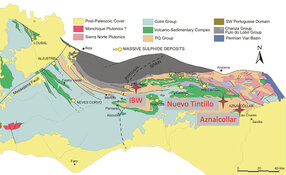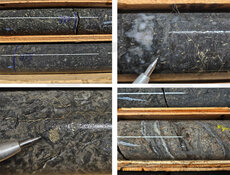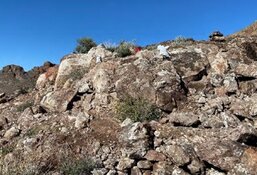Chris Ecclestone: Every metal and mineral has a different story. At this moment, some precious metals—like gold and silver—are in a crisis, but platinum and palladium are not. A big-brush approach to these markets can lead to errors. For example, if iron is weak, to conclude that coal is weak would be wrong. That might be true for metallurgical coal, but not for coal used for energy generation. Mid-month, the lead price got above $1 per pound ($1/lb), which was a significant recovery from its lows. The zinc price has been creeping up again. The copper price is not bad at levels about $3/lb. But the iron ore price totally plunged. So there isn't just one thing going on here.
In the specialty metals, it's all about the market conditions for each particular metal. You can have a situation where a primary metal is out of favor, but the alloying specialty metal is not if the specialty metal is in temporary short supply or under political export pressure. Another example of each metal having its own story is the major base metals—lead, zinc, nickel—they were already kicked in the teeth a long time ago. Zinc is nowhere near its 2008 highs, neither is lead, and nickel peaked years before that. It's invalid to lump them all together; they need to be analyzed separately.
Reviewing the rare earth element (REE) metals situation is instructive. What looked to be a situation of mixed shortage and surplus among this large group of metals was turned into a big drama. Enormous expectations developed, as did "certainties" of shortages for some REEs, and that sent some of the prices through the roof. The trouble with REEs is you can't divide the pack. You have to take the whole suite—the good, the bad and the ugly. That's what sabotaged the story for the REEs. Lanthanum and cerium, which were the two biggest components of any REE mix, were in oversupply. So again—each metal has a story.
TMR: What is the most compelling specialty metals story right now?
CE: Antimony, though it's technically a metalloid. The antimony market has seen little investment for years because of waning China dominance. Now, new applications for antimony are shaking out the old producers and changing the market dynamic. Most Western mines closed down decades ago, but recently, a few Western mines have reopened, although not enough to make up for reduced Chinese exports. As a result, I expect antimony to be strong. A similar situation exists with other metals like gallium, germanium, selenium and some REEs.
TMR: What is the new application driving demand?
CE: Antimony's biggest rising usage is as a flame retardant in plastics used by the auto industry. After years of having the price of antimony at $2,000 ($2K), $3K and $4K per ton, now it's at $10K/ton and it was as high as $15K/ton. That's a good example of a new technology but not a sexy technology, like the REEs used in cell phones. By comparison, antimony is boring but absolutely vital.
TMR: How can an investor get exposure to antimony?
CE: There are a couple of options. One is Toronto-listed Mandalay Resources Corp. (MND:TSX). It's a gold-antimony mine in Australia. Another option is the South African company Village Main Reef Ltd. (VIL:JSE), which has the Consolidated Murchison (Cons Murch) gold-antimony mine in South Africa. Gold deposits often are associated with antimony, so it has a double-whammy positive effect because both elements have high value. Given the choice between a gold deposit and a gold-antimony deposit, I would take the latter.
TMR: Lately, you've written a lot about mergers and acquisitions (M&A). You categorize M&A deals as either "obvious" or "huh/what?" You dubbed the potential deal between HudBay Minerals Inc. (HBM:TSX; HBM:NYSE) and Thompson Creek Metals Co. Inc. (TCM:TSX; TC:NYSE) "obvious". How did you come to that conclusion?
CE: That's a good example of a deal that makes sense to everybody except current management. The companies' managements say "no, no, no" because it theoretically means someone is going to lose their seat at the table. They don't want to fall into the funeral procession of some of their colleagues they used to hang out with at PDAC (Prospectors and Developers Association of Canada) conference with their ancient whiskeys and big cigars. There are other deals that could make sense— Lundin Mining Corp. (LUN:TSX) and HudBay, which was a deal proposed back in 2008 and didn't happen. Or Mercator Minerals Ltd. (ML:TSX) and First Quantum Minerals Ltd. (FM:TSX; FQM:LSE). However, First Quantum is currently digesting the acquisition of Inmet Mining Corp. (IMN:TSX).
Instead of buying a company, Capstone Mining Corp. (CS:TSX) bought a mine by purchasing Pinto Valley from BHP Billiton Ltd. (BHP:NYSE; BHPLF:OTCPK). The market thought the deal was expensive, but to Capstone (and to us), it made a lot of sense. The purchase turned Capstone in a multi-mine copper company. There are other examples of sensible and obvious M&A examples in the gold sector. More interesting to me is when mid-sized diversified miners join together and create companies that have the critical mass to become majors.
Costs are the talk of the industry right now—energy, labor, etc. Yet costs at head offices are much less discussed. If you combine two head offices, it's like 1+1=1 because you only have one management team surviving. You don't need to have two investor relations people. You don't need all the flimflam. One head office gets the chop, and that saves money. In some cases, you cannot save more money at the mine, but you can save money at the head office. There are an awful lot of overpriced, overpaid midtier mining people. When you put two companies together, you can make economies of scale.
Good deals also diversify companies across metals. A company can be all zinc and if zinc goes bad, you're really done for. Merging a copper mid-tier with a zinc or nickel producer makes sense for a lot of reasons. You get geographic and product diversification. Geographic concentration brings risks. A good example of that is Centamin Plc (CEE:TSX; CNT:ASX, CEY:LSE), which operates in Egypt and saw its market cap wilt from $3.5 billion ($3.5B) down to $600 million ($600M). It is easy to find examples of companies that are down 80%, but not many $3.5B companies are down 80%. Another example of a company that has had issues due to geographic concentration is Centerra Gold Inc. (CG:TSX; CADGF:OTCPK). Centerra has had problems with its main mine, Kumtor, which is in the Kyrgyz Republic. If you run into problems and you only have one mine, you have a big problem. There is no other story to tell investors. The pattern is a familiar one and has happened in all sorts of different places.
TMR: Of the potential mergers you mention, most have geographic diversity as well as a mix of nonferrous base metals. Is that a theme for you going forward?
CE: If there is an economic recovery, you have to bet on base metals. If risk goes down, the appetite for gold goes down. With recovery, the chance of Quantitative Easing (QE) being extended goes down. The inflation fears abate. It's not looking good for gold, though it may have a floor.
TMR: Is the current financing climate putting the brakes on bad or high-risk mergers?
CE: It's the bad past examples more than the financial crisis that has curbed high-risk mergers. If we hadn't had these bad examples, companies would be out there doing the same dumb deals. Many potential acquiring companies have cash. Some of the worst companies have piles of cash. They might have had big write-offs of what they bought in the past and since then, they've generated a lot more new spending money. Many mining executives seem to think a $7B property is a great bargain. But why not buy three diversified, million ounce properties for $50M each, rather than buy one 3 million ounce (3 Moz) mega-mine property for $2B? Same amount of ounces, big difference in price. The trouble is many majors would rather pay $1B to buy a 3 Moz mine that's in one location. This gigantism has now come back to haunt them. The Seabridge Gold Inc. (SEA:TSX; SA:NYSE.A) KSM project, Novagold's Galore Creek and Barrick Gold's (ABX:TSX; ABX:NYSE) Pascua Lama project will all be in the history books. No one is going to do a $10B, 20-year project even in the mid-term future in the gold mining sector.
TMR: Do you have any examples of recent good deals?
CE: New Gold Inc. (NGD:TSX; NGD:NYSE.MKT) recently made a really great deal, but the market slapped the stock down because the market says any deal is a bad deal. Capstone got slapped down when it did Pinto Valley. I think that after a few weeks, they recover. But a bad deal is obvious. Everyone just looks at it and says, "huh/what?" Those mining companies are the ones whose CEOs are gone a few months later if they haven't already bit the dust. The surviving group has been getting smaller and smaller.
TMR: In your most recent monthly letter, you describe rotations. Most investors rotate from hot sectors into perceived growth opportunities looking for the next big thing. You're proposing investors outside the mining sector are going to look at this beaten up sector as an opportunity. Are new investors rotating into the mining sector soon?
CE: I don't think the rotation is coming; I think it is here. People look at the U.S. equity market and feel skittish. Between inflation and index changes, the market hasn't gone anywhere since 2008. But, at the same time, people like to be moving. Brokers don't make money by investors hanging on to stocks. They make money out of persuading clients to rotate. It becomes a bit of a self-fulfilling prophecy. There is something for each member of the financial community; the brokers, the strategists and the hedge funds guys. For example, the hedge fund guys get itchy fingers if they're sitting at the desk and haven't done a trade for half an hour.
But they don't want to be buying just more of the same old Apple or index fund. They want to be buying something novel. They want to be seen to be doing something. That's why there will be a rotation. The rotation should mean that the largest miners will see stronger share prices. They'll benefit because they're in indexes. Ask your average hedge fund manager who's never done mining, "name me a mining company", and he'll say, "Barrick" or "BHP." Ask your average hedge fund manager about Agnico-Eagle, and the response will be "What? Is that a brand of Swiss watch?" He won't know what that stock is unless he's been there, done that in the past.
It is interesting that Soros Fund's reduced heavily their expsoure to physical gold ETFs. It's quite clear that the physical gold exchange-traded funds (ETFs) are suffering. Soros bought options on the Gold Miners ETF (GDX). Buying options on GDX is an interesting trade because the ETF operator is not actually buying the underlying stocks. Someone else is taking the risk, whoever the option writer is. As we know, many mining stocks are now illiquid. If George Soros ever goes to exercise his options and they have to deliver him ETF shares, then they have to go to the ETF manager, which is Van Eck. Van Eck would then have to race out into the market and start buying all the stocks that make up the ETF so that it can create the units that it would then deliver. Soros could create a squeeze—and remember, George Soros' middle name is "Squeeze"—and really blow that whole dead zone of the ETFs out of the water. Whoever wrote those options is crazy because they are on the wrong side of George Soros in a small market. There is a trade there for a smart fund manager.
TMR: Are there any other strategic minerals investors should take a look at?
CE: Fluorspar is nice. It's not in exceptionally short supply, but there are very few companies exploring for or mining it. Canada Fluorspar Inc. (CFI:TSX.V) is still moving forward, though not as fast as many people would like. The financing is tough. The only way to do most of these projects is with an offtake agreement. Canada Fluorspar has one. An offtake agreement is not the solution to everything, but it is a big step in the right direction.
TMR: Any strategic minerals to watch?
CE: There are lots of other interesting materials like tellurium, selenium, gallium and germanium. Gallium and germanium are both high-tech elements that the Chinese have a total headlock on at the moment and have had for a long time. Very few Western companies are making any effort to get out there and find those minerals.
TMR: They're generally byproducts of zinc refining?
CE: Some of them are, but you can find primary mines. Many gold deposits contain a little antimony, a bit of bismuth and whatever else. The minor metals weren't really considered much. With tellurium, for example, there are no primary tellurium mines, but there are gold deposits with tellurium byproduct. I would focus not on pure gold deposits now. I would focus on gold deposits where you get something else in the mix. A polymetallic deposit is a safety net. I'd rather have a silver-zinc mine than a pure silver mine.
TMR: What is the single most important theme for metals investors at this point in the strategic metals space?
CE: The idea is to be cheap. Look for companies that buy assets cheap. It's as simple as that. I think many of the managements of the big miners wouldn't know cheap if they fell over it. They've been overpaying for deposits and overpaying themselves in the process. Avoid companies where "cheap" isn't in their vocabulary. Avoid management with a track record of blowing away your capital while they blow away their credibility. It is an unfortunately common pattern in the mining industry.
TMR: It has been interesting and entertaining to speak with you. We look forward to talking to you again.
CE: Thanks.
Christopher Ecclestone is a principal and mining strategist at Hallgarten & Co. in New York. He is also a director of Mediterranean Resources, a gold mining company listed on the Toronto Stock Exchange, with properties in Turkey. Prior to founding Hallgarten & Co. in 2003, he was the head of research at an economic think tank in New Jersey, which he had joined in 2001. Before moving to the U.S., he was the founder and head of research at the esteemed Argentine equity research firm, Buenos Aires Trust Company, from 1991 until 2001. Prior to his arrival in Argentina, he worked in London beginning in 1985 as a corporate finance and equities analyst and as a freelance consultant on the restructuring of the securities industry. He graduated in 1981 from the Royal Melbourne Institute of Technology.
Want to read more Metals Report interviews like this? Sign up for our free e-newsletter, and you'll learn when new articles have been published. To see a list of recent interviews with industry analysts and commentators, visit our Metals Report homepage.
DISCLOSURE:
1) Alec Gimurtu conducted this interview for The Metals Report and provides services to The Metals Report as an independent contractor. He or his family own shares of the following companies mentioned in this interview: None.
2) The following companies mentioned in the interview are sponsors of The Metals Report: Mandalay Resources Corp. Streetwise Reports does not accept stock in exchange for its services or as sponsorship payment.
3) Chris Ecclestone: I or my family own shares of the following companies mentioned in this interview: None I personally am or my family is paid by the following companies mentioned in this interview: None. My company has a financial relationship with the following companies mentioned in this interview: None. I was not paid by Streetwise Reports for participating in this interview. Comments and opinions expressed are my own comments and opinions. I had the opportunity to review the interview for accuracy as of the date of the interview and am responsible for the content of the interview.
4) Interviews are edited for clarity. Streetwise Reports does not make editorial comments or change experts' statements without their consent.
5) The interview does not constitute investment advice. Each reader is encouraged to consult with his or her individual financial professional and any action a reader takes as a result of information presented here is his or her own responsibility. By opening this page, each reader accepts and agrees to Streetwise Reports' terms of use and full legal disclaimer.
6) From time to time, Streetwise Reports LLC and its directors, officers, employees or members of their families, as well as persons interviewed for articles and interviews on the site, may have a long or short position in securities mentioned and may make purchases and/or sales of those securities in the open market or otherwise.









































